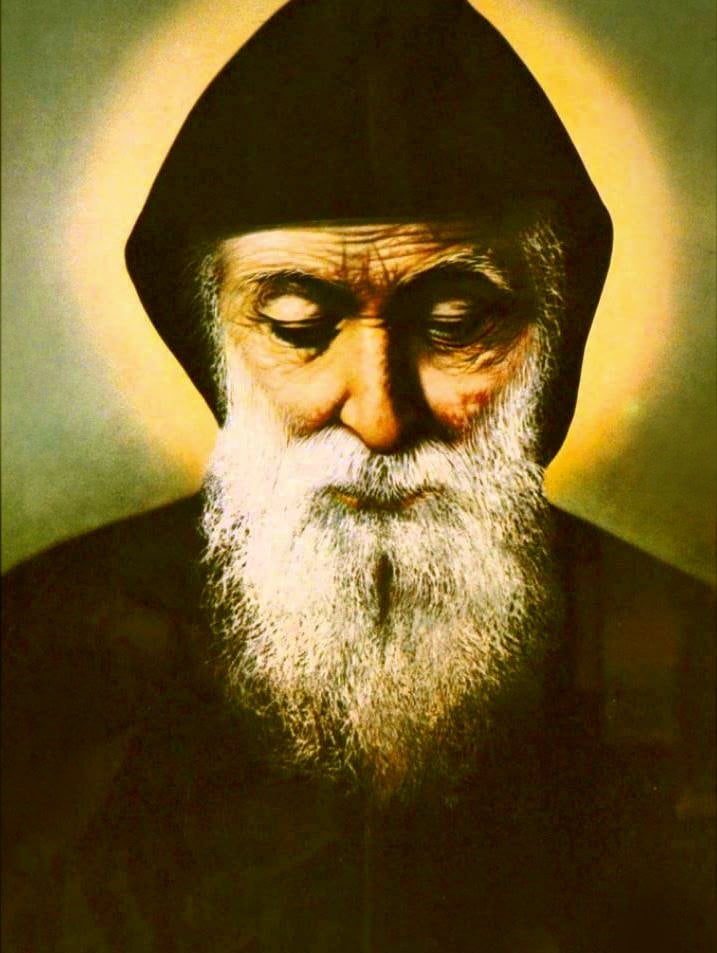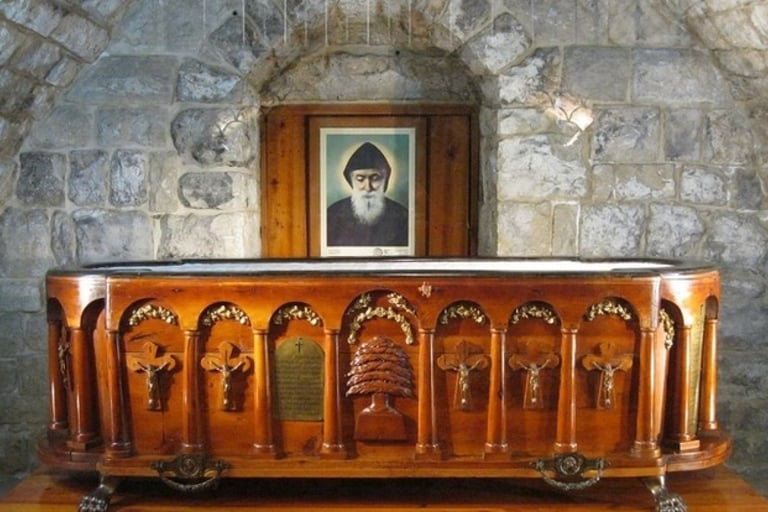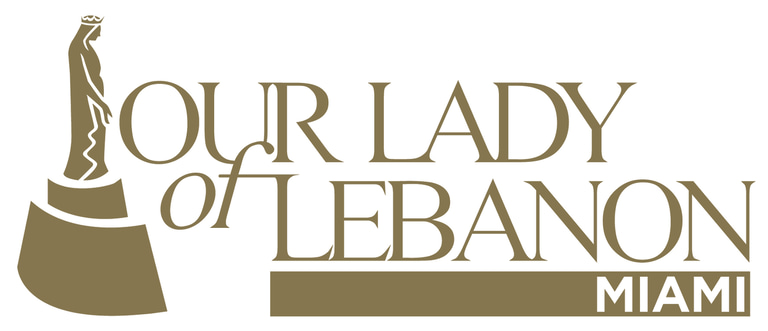Saint Sharbel Makhlouf
I. Early Life and Family Background
Birth Name: Youssef Antoun Makhlouf
Religious Name: Sharbel (after the 2nd-century Antiochian martyr)
Date of Birth: May 8, 1828
Place of Birth: Bekaa Kafra, North Lebanon — the highest inhabited village in the Middle East
Nationality: Lebanese
Language: Syriac-Aramaic (liturgical), Arabic (vernacular)
Rite: Maronite Catholic
Parents: Antoun Zaarour Makhlouf and Brigitta Chidiac
Siblings: Four brothers and one sister
Youssef was born into a devout Maronite Catholic farming family. The family prayed together daily, attended Divine Liturgy faithfully, and fostered a love of the Church and the Blessed Mother. His paternal uncle was a monk, which deeply inspired the young boy. After his father's early death when Youssef was just three, his mother raised him in faith, later marrying a Maronite deacon.
As a child, Youssef was known for his quiet nature and love of solitude. He spent much time in a cave near his home, which he turned into a small personal chapel with an icon of the Virgin Mary. There, he would kneel for hours in prayer. Even as a boy, he practiced austerity, fasting from meat and sleeping on the ground.


II. Entry into Monastic Life
At the age of 23, Youssef left home secretly to enter religious life, knowing that his family would try to dissuade him. He joined the Monastery of Our Lady of Mayfouq, part of the Lebanese Maronite Order (LMO). In 1853, he transferred to the Monastery of St. Maron in Annaya, where he officially received the religious habit and took the name “Sharbel.”
Education and Formation
Sharbel was sent to study at the Kfifan Monastic Seminary, a theological center of learning. There, he studied under two holy men:
Blessed Nimatullah Kassab Al-Hardini, a master of spiritual life and future Maronite saint.
Father Al-Douaihy, a scholarly priest and theologian.
Sharbel distinguished himself by his silence, obedience, and extraordinary discipline. He excelled in the study of Scripture, theology, and Syriac liturgy.
Priestly Ordination
He was ordained a priest on July 23, 1859, by Bishop Joseph al-Marid, at the patriarchal seat of Bkerké. Returning to the Monastery of St. Maron in Annaya, Father Sharbel lived a simple monastic life filled with manual labor, prayer, and spiritual direction.
III. The Hermit of Annaya
In 1875, Father Sharbel requested and received permission to live as a hermit at the Hermitage of Saints Peter and Paul, located above the Monastery of Annaya. He would remain there for the last 23 years of his life, living in near-total solitude and silence.
Lifestyle of Asceticism
Sharbel embraced radical poverty and penance:
He slept on a rough straw mat with a wooden log for a pillow.
His meals consisted of vegetables, legumes, and minimal portions.
He fasted constantly and wore coarse garments.
His daily schedule revolved around prayer, manual labor, and the Divine Liturgy.
He celebrated the Holy Qurbono (Maronite Divine Liturgy) daily, often with deep tears, mystical experiences, and even levitation.
Despite his silence, he radiated warmth and holiness. Many villagers and monks would come to him for prayer, healing, and advice.
IV. Death and Immediate Signs of Sanctity
On December 16, 1898, while celebrating the Divine Liturgy, Fr. Sharbel suffered a stroke during the consecration, just as he elevated the Body of Christ. He was taken back to his cell, where he remained in prayer and suffering until his death on December 24, 1898 — Christmas Eve.
He was buried in the monastery cemetery, but soon after, a blinding light was seen shining from his tomb for 45 consecutive nights. Monks and villagers witnessed the light and began to speak of his holiness.
V. Miracles and Incorrupt Body
In 1899, his body was exhumed and found incorrupt—still flexible, fresh, and exuding blood and liquid.
This phenomenon lasted for decades, and physicians and scientists who examined his body were astonished.
Countless miracles began to be reported:
Healings from paralysis, blindness, tumors, and terminal illnesses.
Dreams and visions of Saint Sharbel appearing to people, often in times of danger or doubt.
Conversions of atheists, Muslims, and others who witnessed his power.
The Lebanese Maronite Order began to document these miracles, many of which were accompanied by official medical reports and eyewitness testimonies.
VI. Canonization and Recognition
Beatification
Date: December 5, 1965
By: Pope Paul VI
Occasion: Closing of the Second Vatican Council
Pope Paul VI declared him “a shining light from the East,” highlighting how Eastern spirituality nourishes the entire Catholic Church.
Canonization
Date: October 9, 1977
By: Pope Paul VI
Pope Paul VI said: “Sharbel has lived the monastic ideal to perfection, uniting the traditions of the East and West, and drawing souls to Christ by his silence.”
Saint Sharbel became the first Lebanese monk canonized in the modern era. His shrine in Annaya became a global pilgrimage site.
VII. Global Devotion and Pilgrimage Sites
The devotion to Saint Sharbel has transcended Lebanon and the Maronite Church. His name and image have become widespread among Eastern and Western Christians, and even among non-Christians.
Pilgrimage Sites
Annaya, Lebanon – His tomb and hermitage draw millions of pilgrims yearly.
Miami, Florida – A New Pilgrimage Destination
Our Lady of Lebanon Maronite Catholic Church in Miami is now home to a first-class relic of Saint Sharbel and is officially recognized as a pilgrimage site during the Jubilee of Hope.
Faithful are encouraged to:
Venerate his relic
Attend the monthly Healing Mass in his honor (every 22nd of the month)
Offer intentions for healing and intercession
Experience the Maronite liturgical tradition rooted in the same spirituality St. Sharbel lived
Hundreds gather each month for this powerful prayer experience, and many testimonies of healing, consolation, and renewed faith have been shared.
This sacred opportunity allows the people of Florida and beyond to encounter Saint Sharbel without traveling across the world. Our Lady of Lebanon – Miami invites pilgrims of all backgrounds to come and receive his blessing.
VIII. Spiritual Message and Legacy
Saint Sharbel’s life offers a radical call to holiness in the modern world. His message includes:
The power of silence in a noisy age
Eucharistic devotion and daily Mass as the heart of life
Prayerful suffering, uniting oneself with Christ crucified
The light of Eastern Christian mysticism in the universal Church
He is especially invoked for:
Healing of body and soul
Peace in the Middle East
Unity of the Churches
Inspiration for clergy, monks, and seminarians
Conclusion
Saint Sharbel Makhlouf is a 21st-century saint for all people, Eastern and Western, sick and healthy, believer and seeker. His quiet, hidden life of holiness continues to bear fruit through miracles and conversions.
To encounter his powerful intercession, pilgrims are warmly invited to Our Lady of Lebanon Church in Miami, where his relic is venerated, and the flame of his holiness continues to shine.
“Through your intercession, O Saint Sharbel, may we be healed in body and soul. Teach us the silence of love, the joy of sacrifice, and the light of Christ. Amen.”
Mass in Honor of St Sharbel every 22nd of the month 8:00 pm
If the 22nd is a Saturday or Sunday, We follow the regular Schedule


Office Hours
Monday – Thursday
9am – 4pm
Friday
9am – 2pm
CONTACT Us
info@ololmiami.org
305-856-7449
© 2025. All rights reserved.
